INTRODUCTION
Post-burn contracture is a known sequelae of burn injuries involving neck, axilla, elbow and hand. It occurs due to disorganized structure of the collagen in the wound areas. Various treatment modalities such as skin grafting are used to release the scars and to restore the function to the joint involved. Even though these surgeries aid in anatomical restoration, functional restoration remains an important issue. After these reconstructive surgeries, patient may develop joint stiffness if post-operative physiotherapy is inadequate which can be due to various reasons such as pain, lost to follow-up, etc. There are many methods which are used as adjuvant in rehabilitation of post-burn contracture patients, one of them and with very few data available from India is low-level laser therapy (LLLT). In this article we share our experience of using LLLT for functional rehabilitation of a patient with joint stiffness following post-burn contracture.
MATERIALS AND METHODS
This study was conducted in a burns centre under Department of Plastic Surgery in a Tertiary care institute in South India during the month of November- December 2021. Informed consent and Departmental Ethical Committee clearance were obtained prior to study. The subject was a young boy with no known co-morbidities with stiffness of metacarpophalangeal and interphalangeal joint of index and middle finger of right hand (Figure 1). Patient was treated with contracture release with full thickness skin graft (Figure 2). Patient developed stiffness of metacarpophalangeal join and interphalangeal joint due to splinting following full thickness skin grafting (FTSG). The patient received LLLT to induce collagenolysis and to increase the movement of the joints.
Figure 1. Post-Burn Contracture Involving Multiple Fingers
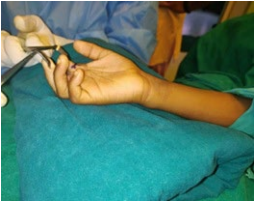
Figure 2. Contracture Release Marking
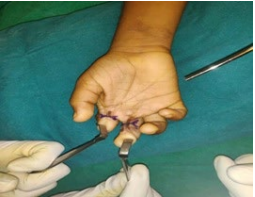
Low-level laser source we used was Gallium Arsenide (gas) diode red laser of wavelength 650 nm, frequency 10 KHZ and output power 100 mw, which was a continuous beam laser with an energy density of 4 J/cm2. Machine delivers laser in scanning mode (non-contact delivery) with 60 cm distance between laser source and the joint. Each joint received laser therapy for duration of 125-second every time for 15-minutes for 2 sessions in a span of 4-days (Figure 3).
Figure 3. Low-Level Laser Therapy Being Applied After PBC Release
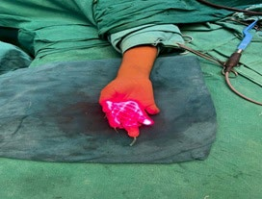
RESULT
Low-level laser therapy has been found to be useful in early rehabilitation of post-burn contracture patients with joint stiffness. (Figures 4 and 5) No side effects were observed during the study.
Figure 4. Condition at Discharge with Near Normal Extension
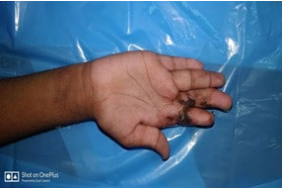
Figure 5. Near Normal Flexion
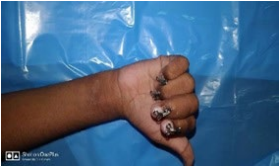
DISCUSSION
Burn injuries are impart a considerable burden on health care system. The burns stand as a common cause of trauma related death second to road traffic accidents in both developing and developed country both acute and long-term events associated with burns patients compels patient to seek medical care. After resuscitation, which is aimed at survival of the victim, restoration to pre-injury status, and return to daily activities becomes important for victim and treating team.1 A healed burn patient may be left with scars with varying degrees of functional issues and cause social stigma among victims.
Post-burn contracture develops because of healing by secondary intention may cause anatomical and functional morbidity to the patient. These patients may also develop mental illness due to the deformity. Rehabilitation in the form of surgery to restore the anatomy, functional rehabilitation in the form of physiotherapy and psychosocial counselling is necessary for the patient to allow him to lead a normal life.
Post-burn contracture leads to deformity due to faulty collagen. LLLT helps in preventing deformity by collagenolysis. This also helps in preventing joint stiffness following splinting.
The acronym “light amplification by stimulated emission of radiation (LASER)”, are defined by a power density at <l500 mW/cm2.2,3 Energy used in LLLT is much less than the one used for cutting, and ablation therapy. LLLT is a form of phototherapy that employs electromagnetic radiation, that can generate enough energy for interacting with living tissues. It produces photochemical and photophysical effects without generation of heat, with consideration of re-establishing cell homeostasis. Essentially, light energy is delivered topically in controlled way which is absorbed by photo-absorbers (chromophores) that transform it into chemical energy. 4
Positive effects include increased formation of granulation tissue and acceleration of tissue repair, wound contraction, inflammation, modulation, and pain reduction.4
As per literature, low-energy photoemissions given at a wavelength range of 600 nm to 900 nm accelerate cell proliferation and promote wound healing.5 Its action is thought to:
- Stimulate respiratory chain components promoting adenosine triphosphate (ATP) synthesis,6 and hence increase rate of mitoses and fibroblast numbers.6
- Stimulate collagen and elastin production.7
- Stimulate microcirculation with dilatation of the capillaries and neovascularisation.8
- Cause collagenolysis.9
- Liberate mediator of inflammation-histamine, serotonin and bradykinin and hence activate macrophages.
- Regenerate lymphatic vessels.
CONCLUSION
Low-level laser therapy is found to be useful in management of joint stiffness our patient following contracture release without any side effects. The limitation of the study it was done on a single subject. Hence the authors suggest that a study including multiple subjects with a control group and multiple centres with randomisation to validate the exact result.
CONFLICTS OF INTEREST
The authors declare that they have no conflicts of interest.










